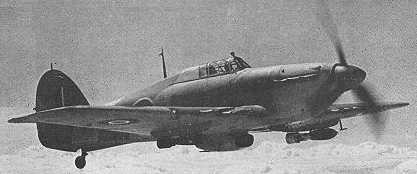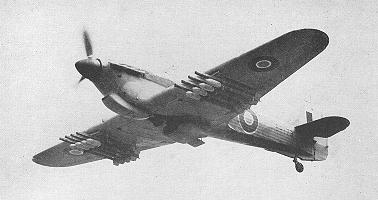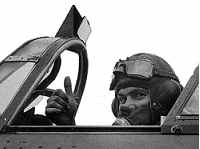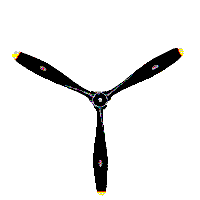|
The
Hurricane destroyed more enemy aircraft than the rest of the RAF together.
It was a much more stable gun-platform, it could out turn an Me-109.
Often
underrated in favor of the Spitfire
, the Hurricane was the main victor of the Battle of Britain. The
Royal Air Force had at that time 32 Hurricane squadrons, compared with 19 Spitfire
squadrons. This meant that 620 Hurricane and Spitfire
fighters (with another 84 assorted fighters like the Gloster
Gladiator) had to face the German air threat of 3,500 bombers and
fighters. During the "Battle of Britain", along with the Spitfire
, it helped to force the Luftwaffe to use the Bf
109 to protect the poor performing twin engine Bf
110 escort fighter.

The
Hawker Hurricane
The synthesis of many years' intimate experience of fighter biplane design
translated into the modern formula; a compromise between tradition and
requirements born of a new era in air warfare--such was the Hawker
Hurricane. The first fighter monoplane to join the Royal Air Force and the
first combat aircraft adopted by that arm capable of exceeding 300 m.p.h.
in level flight, the Hurricane shouldered the lion's share of Britain's
defense during the " Battle of Britain", and was largely
responsible for the successful outcome of this conflict for the defending
forces, equipping more than three-fifths of R.A.F. Fighter Command's
squadrons. The Hurricane also proved to possess an astounding propensity
for adaptation, and the multifarious roles that it undertook earned for it
the distinction of being the most versatile of single seat warplanes to
emerge from the Second World War.
The Hurricane was the work of Sydney Camm, who began its design in 1934.
The prototype first took to the air on November 6,1935, at Brooklands, and
the initial production Hurricane I entered RAF service in December 1937,
with No 111 Squadron. Powered by the famous Rolls-Royce Merlin engine,
it became the first RAF monoplane fighter with an enclosed cockpit and
retractable undercarriage, its first fighter capable of a level speed in
excess of 483 km/h (300 mph), and its first eight-gun fighter.
Under the command of Sqn. Ldr. J. W. Gillan, No. 111 Squadron quickly
settled down with its new monoplanes, and on February 10, 1938, the
commander personally demonstrated the prowess of the Hurricane by flying
from Edinburgh to Northolt at an average speed of 408 m.p.h. Even with a
stiff tail-wind this was a remarkable performance. Squadrons were rapidly
equipped with the Hurricane--thanks to the foresight of the Hawker
Aircraft directors--and at the time war was declared, on September 3,
1939, just short of 500 Hurricanes had been delivered and eighteen
squadrons had been equipped. These were all of the Mark I type, armed with
eight 0.303-in. machine-guns but having alternative propeller
installations: a Merlin II engine driving a Watts two-blade fixed-pitch
wooden propeller, or a Merlin III of similar power having a standardized
shaft for de Havilland or Rotol three-blade metal propellers. The
Hurricane I, at 7,127 Ib. all-up weight, possessed a maximum speed of 325
m.p.h. at 17,500 feet, a range of 700 miles at 200 m.p.h. at 15,000 feet,
a service ceiling of 36,000 feet, and the ability to climb to 20,000 feet
in 9 minutes.

Hawker
Aircraft Limited evolved from Sopwith
The
early history of the Hurricane is an interesting parallel in many ways
with that of the Supermarine
Spitfire with which it was to form an immortal partnership; but while
the Spitfire was an entirely new conception based on specialized
experience, the Hurricane was the logical outcome of a long line of
fighting aircraft. Thus, although the two airplanes met broadly the same
requirements, they represented entirely different approaches to the same
problem. The two approaches were reflected to an interesting degree in
their respective appearances; the Hurricane workmanlike, rugged and
sturdy, the Spitfire
slender and ballerina-like. One was the studied application of
experience, the other a stroke of genius.
Early in 1934 Sydney Camm, chief designer of Hawker Aircraft, learned of
the work being undertaken by Rolls-Royce to develop a powerful new engine,
then known as the PV-12. At that time the Hawker design team had
been working on a fighter project known as the Fury Monoplane which
had been designed around the 660 h.p. Rolls-Royce Goshawk steam-cooled
engine. As the new engine offered a substantial improvement in
performance, the projected fighter was re-designed for the new power
plant. In view of Air Ministry interest, project design work was rapidly
completed, stressing commencing in March 1934, and work on detail drawings
beginning in May.
On October 23,1935, the prototype fighter, bearing the serial number
K5083, was moved from Kingston to Brooklands for its first flight, which
was effected on November 6 with P. W. S. "George" Bulman, the
company's chief test pilot, at the controls. As measured at Brooklands,
the prototype's loaded weight was 5,416 lb. The Hawker monoplane was a
clean aircraft. Its tubular metal construction and fabric covering were
similar to those of the earlier Fury fighter biplane, and many of
its contours, particularly the tail surfaces, were characteristic of
earlier Camm designs. The continued adherence to fabric covering was
viewed with misgivings by some, and was, in fact, soon to be supplanted by
metal skinning for the wings; but this seemingly dated feature was linked
with what were for that time ultra-modern items such as a fully
retractable under-carriage and a sliding cockpit canopy. For its first
flight the fighter was powered by a Merlin "C", the name
that had earlier been bestowed upon the PV-12, which drove a Watts
two-bladed, fixed-pitch wooden propeller.
During the Battle of Britain, which began in earnest on August 8,1940,
Hurricanes concentrated mainly on the destruction of the German Heinkel
He 111 and Dornier Do 17 bombers. These were the aircraft that
would cause the most damage if allowed to get through. The only Victoria
Cross ever awarded to a Fighter Command pilot was won by Ft Lt James
Nicolson, a Hurricane pilot of No 249 Squadron who, on August 16,1940,
while attacking a German aircraft in front of him, was pounced on from
above and behind by other German aircraft. Nicolson's aircraft caught
fire, but he continued his attack until he had shot down his original
target, then parachuted to safety. The highest scoring Allied pilot of the
battle - a Czech named Sergeant Josef Frantisek, who claimed 17 victories
- was also a Hurricane pilot.
|
Specifications:
|
|
Hawker
Hurricane II B
|
|
Dimensions:
|
|
Wing
span:
|
40
ft. 0 in. (12.19 m)
|
|
Length:
|
32
ft. 3 in. (9.82 m)
|
|
Height:
|
8
ft. 9 in. (2.66 m)
|
|
Weights:
|
|
Empty:
|
5,658
lb (2,566 kg)
|
|
Operational:
|
8,470
lb. (3,841 kg) with two 500-lb. bombs.
|
|
Performance:
|
|
Maximum
Speed:
|
340
m.p.h. (547 km/h) @ 21,000 ft. (6,400 m) clean
320 m.p.h. (514 km/h) @ 19,700 ft. (6,004 m) with two 250-lb.
bombs
307 m.p.h. (494 km/h) @ 19,500 ft. (5,943 m) with two 500-lb.
bombs
|
|
Service
Ceiling:
|
40,000
ft. (12,192 m); clean
33,000 ft. (10,058 m); with 500-lb. bomb load.
|
|
Range:
|
460
miles (740 km) at 178 mph (286 km/h) normal fuel.
920 miles (1,480 km) with two 44 gallon auxiliary tanks.
|
|
Powerplant:
|
|
One
Rolls-Royce Merlin XX twelve-cylinder 60 deg. Vee
liquid-cooled engine
rated at 1,280 h.p. (954 kw) @ take-off and
1,850 h.p. (1,379 kw) @ 21,000 ft. (6,400 m).
|
|
Armament:
|
|
Twelve
0.303-in. browning machine-guns and
two 250-lb. or 500-lb. bombs or eight rocket projectile
|
When
it became clear that the Hurricane was becoming outclassed as a pure
fighter, other duties were assigned to it. In October 1941 the 'Hurribomber'
fighter-bomber came into being, carrying either two 113 kg (250 lb) or two
226 kg (500 lb) bombs under its wings. The Mk IID of 1942 was fitted with
two 40 mm cannon for tank busting and two machine-guns, and was operated
mainly in North Africa against Rommel's desert forces and in Burma against
the Japanese. Other Hurricanes carried rocket projectiles as alternative
ground attack weapons.

The year 1943 saw two important developments in the Hurricanes
history--the introduction of the Mark IV and the adoption of the Hurricane
to fire rocket missiles or, as they were initially known, "unrifled
projectiles". The Hurricane IV differed from the Mark II in two
respects: it used a Merlin 24 or 27 which developed 1,620 h.p. for
take-off, and it featured "low attack" or universal armament
wings. These wings were derived from those fitted to the Hurricane IID and
could carry the 40-mm. Vickers or Rolls Royce cannon, bombs, drop-tanks or
rocket projectiles. The Hurricane IV was in service by March 1943 and was
operational in the Middle and Far East theatres until the end of the war,
and in Europe until the end of 1944. The development of the aircraft
rocket had introduced a new factor in the use of aircraft as
ground-assault weapons, and the Hurricane IIB and IIC were the first
single-seaters to employ the rockets operationally. After extended trials
at the A. & A.E.E. and elsewhere with rockets launched from Hurricanes
(commencing with Z2415 which was fitted with three launching rails under
each wing early in 1942), No. 137 Squadron took its rocket carrying
Hurricanes into action for the first time at the beginning of September
1943. Hurricane IIBs, IICs, and IVs were fitted with four rockets under
each wing.
Perhaps the most important sub-variant was the Sea Hurricane. This
operated from aircraft carriers, being fitted usually with catapult spools
and arrester hook. However, most Sea Hurricanes were not newly-built
fighters but converted RAF types, and were deployed originally not for
aircraft carrier operations but to protect merchant shipping. To combat
German maritime-reconnaissance bombers, some ships were converted into
CAMs (catapult aircraft merchantmen) which meant that a Hurricane fighter
could be launched from the ship when danger approached. The biggest
problem was that the fighter could not re-land on board, and so the pilot
had to ditch it in the sea. The main areas of operation for the 'Catafighters'
were in the Mediterranean and Baltic, but by 1943 the Sea Hurricane had
all but disappeared from service.
Of
the 14,533 production Hurricanes built, some had gone for service with
other air forces. In particular, nearly 3,000 were dispatched to the
Soviet Union to aid its fight against the Germans on the Eastern Front.
The first Hurricane sorties in Russia were made on September 11,1941 in
defense of Murmansk, pilots from France, Britain and America helping the
Soviets in their task.

REFERENCE
-
Churchill,
Winston (1948–1953), The Second World War, 6 vols.
-
Gilbert,
Martin (1995). Second World War, Phoenix. ISBN
1857993462.
-
Keegan,
John (1989). The Second World War, Hutchinson. ISBN
0091740118.
-
Liddel
Hart, Sir Basil (1970). History of the Second World War,
London: Cassell. ISBN
0304935646.
-
Murray,
Williamson and Millett, Allan R. (2000). A War to Be Won: Fighting
the Second World War, Harvard
University Press. ISBN
067400163X.
-
Overy,
Richard (1995). Why the Allies Won, Pimlico. ISBN
0712674535.
-
Shirer,
William L. (1959). The
Rise and Fall of the Third Reich, Simon & Schuster. ISBN
0671624202.
-
Smith,
J. Douglas and Richard Jensen. World War II on the Web: A Guide to
the Very Best Sites (2002)
-
Weinberg,
Gerhard L. (1994). A World at Arms: A Global History of World War
II, Cambridge
University Press. ISBN
0521443172.
LINKS:
Kent
Battle Of Britain Museum
All
Wood Wings - quality model airplanes handcrafted from wood
[
Buccaneer ] [
Canberra ] [
Ercoupe ] [
Gannet ] [
Harrier ] [
Hunter F.51 ] [
Hunter T.7 ] [Jaguar]
[
Lightning ] [
Meteor ] [Pembroke
] ] [
Provost ] [
Sea Hawk ] [
Sea Prince ] [
Sea Vixen [
Shackleton ] [
Venom ] [
Victor Nose ] [
Whirlwind ] [
Engines ] [Models] [Links]
Battle
of Britian
Calendar
Aircraft
Links
Commanders
Units
& stations Gallery
David
Ben-Gurion
Ho
Chi Minh
Winston
Churchill
Mohandas
Gandhi
Mikhail
Gorbachev
Adolf
Hitler
Martin
Luther King
Ayatullah
Khomeini
V.I.
Lenin
Nelson
Mandela
Pope
John Paul II
Ronald
Reagan
Eleanor
Roosevelt
Franklin
D. Roosevelt
Teddy
Roosevelt
Margaret
Thatcher
Margaret
Sanger
Lech
Walesa
Mao
Zedong
General
-
- Media
Media
-
- Stories
Stories
-
- Specific
Specific
-
WWII
US women's service organizations — History and uniforms in color
(WAAC/WAC, WAVES, ANC, NNC, USMCWR, PHS, SPARS, ARC and WASP)
-
Germany's
surrender documents.
-
Online
Newspaper Archive
-
Veterans
Of The US Armed Forces Services, information, resources, and image
gallery for veterans of the United States Armed Forces.
-
Front
page of the 6 June, 1944 edition of The
New York Times.
-
Using
Historical Statistics To Teach about World War II. ERIC Digest.
-
World
War II in the Curriculum
-
Speech
delivered by premier Benito Mussolini (Rome, Italy, February 23, 1941)
-
Daily
reports - Extremely detailed daily action reports from the German
side
-
Juno
Beach - An indepth examination of one of Canada's
greatest WWII contributions: Juno
Beach.
AVIATION
A - Z
A
taste for adventure capitalists

Solar
Cola - a healthier alternative
|



